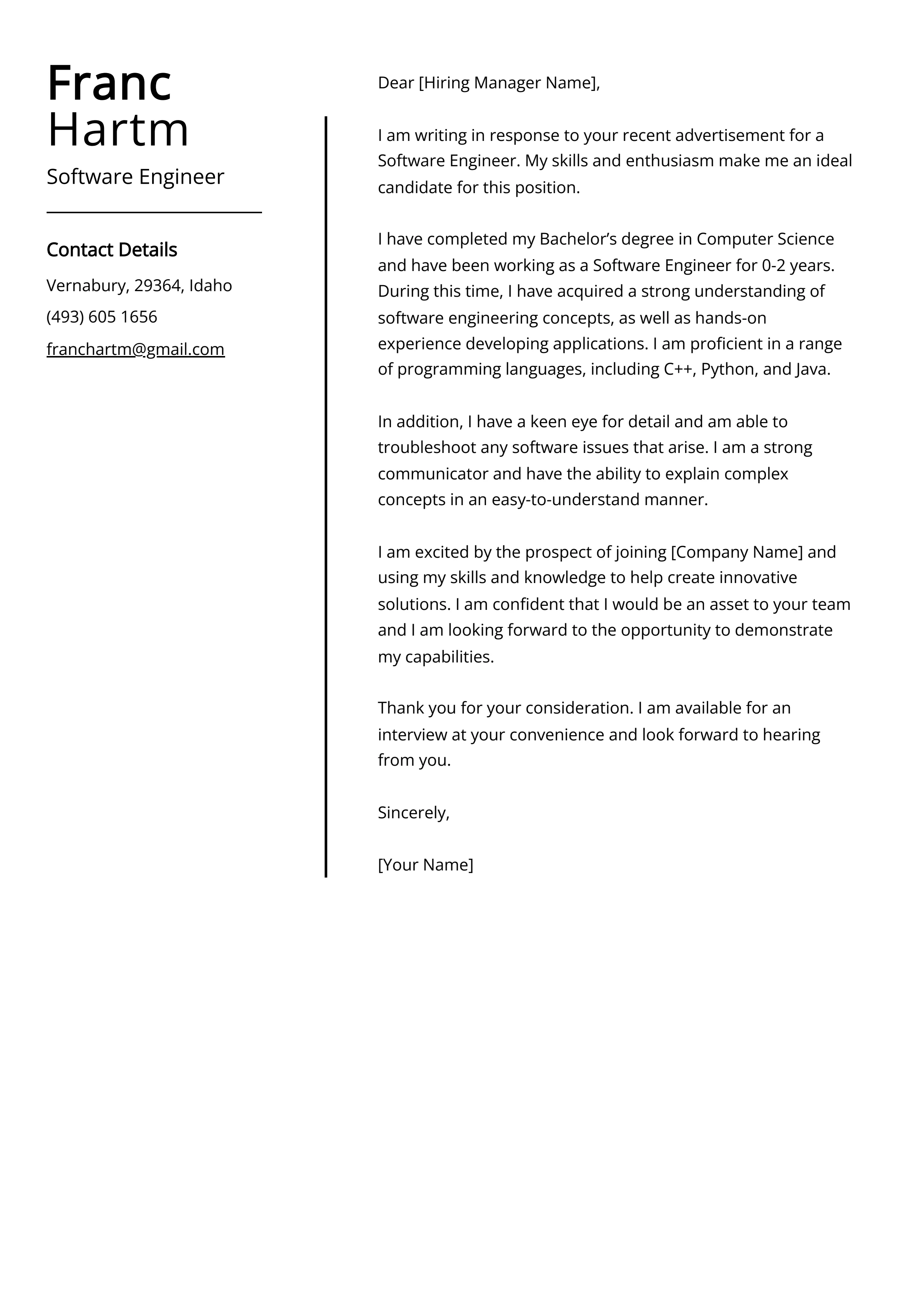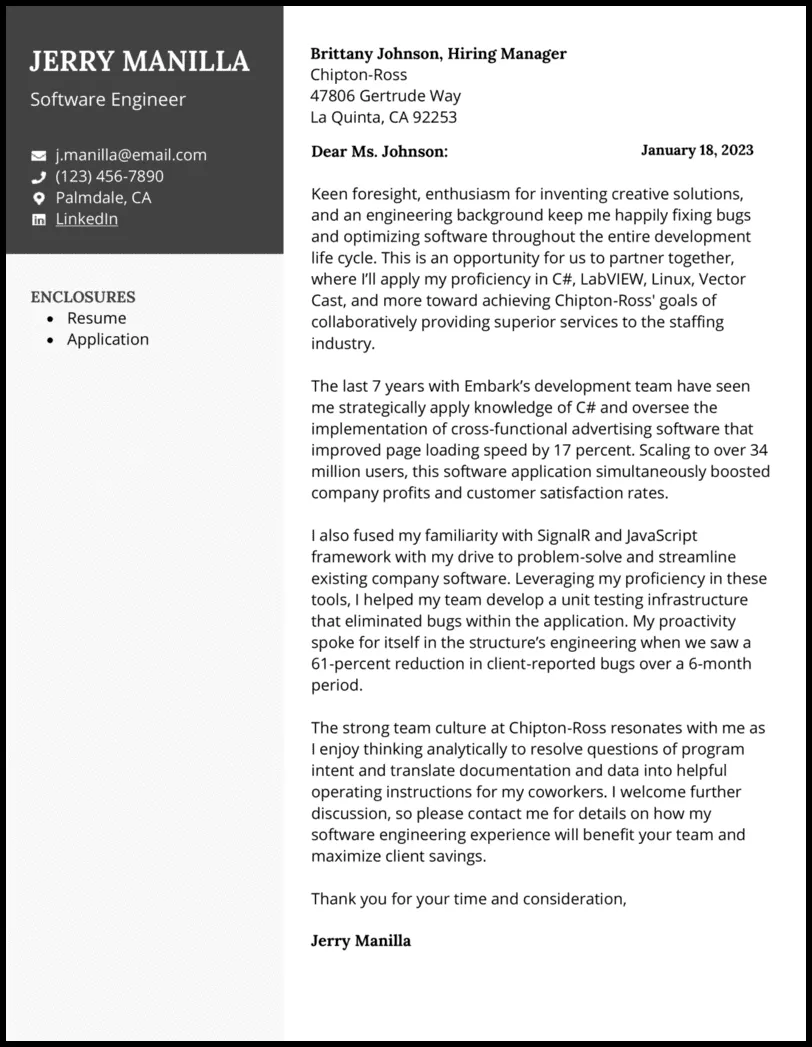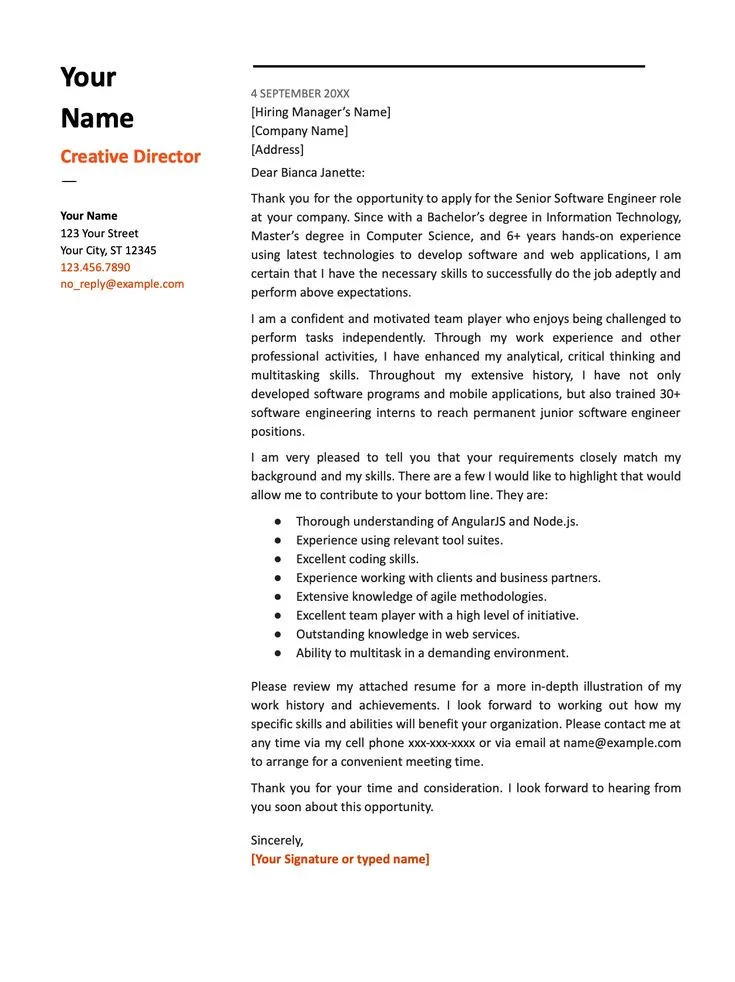Understanding the Importance of a Cover Letter
In the competitive world of software engineering, a well-crafted cover letter can be your golden ticket to landing your dream job. Many software engineers underestimate the power of a cover letter, viewing it as a mere formality. However, it is your first opportunity to make a strong impression on a potential employer. It is a chance to go beyond the bullet points of your resume and tell a compelling story about your skills, experience, and passion for software engineering. A cover letter is not just a summary of your resume, it is a narrative that showcases your personality, enthusiasm, and suitability for the specific role you are applying for. This document allows you to highlight the experiences and projects that align perfectly with the job description, making you stand out from other applicants. It allows you to demonstrate your communication skills and prove that you took the time and care to match your skills and experience with the company’s needs.
Your cover letter acts as a personal introduction, setting the stage for a more in-depth conversation about your qualifications. It is where you can connect your past accomplishments with the future needs of the company. When done well, it showcases not only your technical prowess but also your soft skills, such as problem-solving abilities, teamwork, and communication. By taking the time to write a tailored cover letter, you signal to the hiring manager that you are genuinely interested in the position and have taken the initiative to learn about the company and the role. This attention to detail and dedication will help you to make a positive impression and increase your chances of moving forward in the hiring process. Remember, a well-written cover letter could be the deciding factor in an employer’s decision to invite you for an interview. In the world of software engineering, where precision and attention to detail are paramount, a polished cover letter can set you apart from the rest.
Key Components of a Software Engineer Cover Letter
Crafting an effective cover letter involves several key components that work together to present a comprehensive view of your skills and experience. First, begin with your contact information, which includes your name, address, phone number, email, and professional social media profiles, like LinkedIn. Following this, address the hiring manager by name if possible. Research the company and find out who is in charge of hiring. If you can’t find the name of the specific hiring manager, address the letter to ‘Hiring Manager’. The introduction should clearly state the position you are applying for and how you found out about it. Briefly mention why you are interested in the role and the company.
The body of your cover letter is where you provide the most detail, highlighting your relevant skills and experience. Use this space to demonstrate how your qualifications meet the requirements listed in the job description. Include specific examples and quantifiable achievements that showcase your abilities. In the closing paragraph, reiterate your interest in the position and express your enthusiasm for the opportunity to contribute to the company. Include a call to action, such as stating your availability for an interview and thanking the hiring manager for their time and consideration. Keep your letter concise, well-organized, and easy to read, using clear and precise language. Use professional formatting and proofread carefully for any errors in grammar or spelling. By incorporating these key components, you can create a cover letter that not only highlights your qualifications but also demonstrates your genuine interest in the software engineering role.
Contact Information and Introduction

Your cover letter should begin with your contact information, which should be clearly displayed at the top. Include your full name, professional title (e.g., Software Engineer), phone number, email address, and your LinkedIn profile URL. This section ensures the hiring manager can easily reach you. Following your contact information, address the hiring manager directly. If possible, research the hiring manager’s name and use it. If a name is unavailable, address the letter to the ‘Hiring Manager’ or ‘Recruiting Team’. This personalized approach demonstrates that you have taken the initiative to research the company and the role. Your opening paragraph should immediately state the position you are applying for and where you saw the job posting. Be specific about the role and company. Then, briefly explain your interest in the position. Mention something that attracted you to the company or the role. Show enthusiasm and demonstrate your excitement about the opportunity. Avoid generic opening lines and aim to create an immediate connection.
In the introductory paragraph, express your genuine interest in the position. This should not just be a statement of your intention to apply. Show that you are enthusiastic about the opportunity to contribute to the company. A good introduction is crucial because it sets the tone for the rest of your cover letter. A well-written introduction immediately grabs the reader’s attention and encourages them to continue reading. It also allows you to demonstrate your communication skills. By crafting a compelling opening paragraph, you will ensure that the hiring manager is interested in learning more about your qualifications and how you align with the company’s needs. Always make sure your introduction is concise and to the point, getting straight to the point without overwhelming the reader with excessive detail.
Highlighting Your Skills and Experience
The core of your cover letter should focus on highlighting your most relevant skills and experience. Carefully review the job description and identify the key requirements. Then, use the body of your cover letter to demonstrate how your experience and skills align with these requirements. Provide specific examples of your accomplishments in previous roles, using the STAR method (Situation, Task, Action, Result) to structure your narratives. For example, describe a situation where you faced a challenging technical problem, the specific tasks you undertook to solve it, the actions you took, and the positive results you achieved. This structured approach helps the hiring manager understand your abilities and how you approach complex challenges.
Quantify your achievements whenever possible. Instead of just saying ‘improved system performance’, specify ‘improved system performance by 20%’. This provides concrete evidence of your impact. Focus on experiences that align with the role. Tailor your examples to highlight the most important skills and technologies listed in the job description. This shows that you are a strong match. Show, don’t just tell, by using compelling examples and anecdotes to illustrate your points. Demonstrate your understanding of the role and the challenges you might face. By effectively showcasing your skills and experience, you can convince the hiring manager that you are a strong candidate for the position. Provide clear examples of how you have used your skills to solve problems and achieve results, making your qualifications resonate with the recruiter.
Quantifying Achievements & Projects
One of the most effective ways to make your cover letter stand out is by quantifying your achievements and projects. Avoid vague statements and use numbers, metrics, and data to demonstrate the impact of your work. For each project or accomplishment you mention, provide specific details about the outcome. If you worked on a project that improved efficiency, state the percentage of improvement. Did you reduce costs, increase sales, or speed up processing times? Use numbers. When discussing projects, mention the specific technologies and tools you used. This provides a clear picture of your technical skills. Highlight any awards, recognition, or positive feedback you received for your work. This will make your achievements more tangible to the reader.
When describing projects, provide context by explaining the challenges you faced, the strategies you implemented, and the results achieved. The STAR method is a useful framework. For instance, you could describe a situation where you identified a performance bottleneck, the task of optimizing the code, the action of implementing a specific algorithm, and the resulting performance improvement. By quantifying your achievements and providing specific examples, you make it easier for the hiring manager to understand the value you bring to the table. It also demonstrates your ability to assess the results of your efforts and use data to measure success. The more specific your examples, the more compelling your cover letter will be. Quantifiable metrics are crucial to help distinguish you from other candidates. Providing clear evidence of your accomplishments will showcase your value, and make you a stronger contender for the position.
Demonstrating Your Passion for Software Engineering

Showcasing your passion for software engineering is essential for making your cover letter memorable. Highlight what excites you about the field and why you chose this career path. This personal touch helps the hiring manager see you as more than just a list of qualifications. Explain why you are interested in the company and the specific role you are applying for. Research the company’s mission, values, and recent projects. Then, tailor your cover letter to show how your interests align with their work. This demonstrates genuine enthusiasm and a willingness to invest yourself in the company’s goals. Show you stay current with industry trends and emerging technologies. Mention any relevant certifications, courses, or personal projects that demonstrate your desire to continuously learn and grow.
Use language that conveys your enthusiasm for software engineering. Avoid generic phrases and show genuine excitement about the opportunity. Include details that showcase your passion. Whether it is a personal project or a specific technology, make it clear that you enjoy your work. Mention any specific projects or technologies that you are particularly interested in. For example, if you’re passionate about AI, mention a related project. When you can connect your skills and experiences to the company’s needs, you establish yourself as a candidate who is both qualified and excited about the role. Always proofread to ensure your passion shines through and doesn’t become lost in grammatical errors or awkward phrasing. By conveying your passion for software engineering, you will capture the attention of the hiring manager.
Tailoring Your Cover Letter
One of the most important steps in the cover letter writing process is tailoring your letter to the specific job and company. Generic cover letters are easy to spot and often end up in the rejection pile. Instead, take the time to customize each letter to match the specific requirements of the role. Start by carefully reviewing the job description and identify the key skills and qualifications. Highlight how your experience and skills align with these requirements. Use the language of the job description. Incorporate keywords and phrases from the job posting throughout your letter to show that you have carefully considered what the company is looking for. Research the company’s mission, values, and recent projects. Then, customize your letter to show how your skills and experience can help the company achieve its goals. Make sure to explain why you want to work for that specific company and in that particular role. This effort demonstrates your genuine interest.
Focus on the specific needs of the company. Instead of listing all of your skills, focus on the ones that are most relevant to the job. Highlight projects and experiences that match the requirements. If the job description emphasizes a specific technology, project, or skill, make sure it’s prominently featured in your cover letter. A well-tailored cover letter shows the hiring manager that you are not only qualified but also enthusiastic about the opportunity. It shows that you took the time to understand the role and the company’s needs. Customizing your cover letter increases your chances of making a positive impression and securing an interview. The more personalized the letter, the more likely you are to stand out from other applicants.
Addressing the Specific Job Requirements
Carefully address the specific requirements outlined in the job description is vital for a successful cover letter. Begin by thoroughly reviewing the job posting. Create a list of the key skills, qualifications, and experiences that the company is seeking. Highlight each of these requirements in your cover letter, and use specific examples to demonstrate how your skills and experiences match. For each requirement, provide evidence of your abilities. If the job requires experience with a specific programming language, describe how you have used that language in previous projects. If the job requires experience in a team environment, provide examples of how you worked collaboratively with other engineers.
If there are any gaps in your experience, be honest and address them directly. Frame these gaps positively by highlighting your willingness to learn and adapt. Then, show your proactive approach to gaining relevant experience. For instance, if the job requires knowledge of a technology you’re not familiar with, mention any courses or personal projects you’ve undertaken to bridge the gap. This shows that you are motivated and eager to develop the required skills. Always refer back to the job description as you write your cover letter. Ensure that your cover letter clearly reflects the requirements of the role and highlights how you meet the employer’s expectations. When addressing specific job requirements, you demonstrate that you are a strong match for the position.
Formatting and Style

The formatting and style of your cover letter play a crucial role in making a positive first impression. Always use a professional format. Choose a clean, easy-to-read font, such as Arial, Calibri, or Times New Roman, and use a font size between 10 and 12 points. Maintain a consistent font and style throughout the document. Ensure your cover letter is well-organized, using clear headings, subheadings, and bullet points to break up large blocks of text and make it easier to read. Keep your paragraphs concise. Aim for a letter that is no more than one page in length. Use appropriate spacing between paragraphs and sections. Professional formatting signals attention to detail and professionalism.
Use a professional tone, avoiding overly casual language or slang. Write in a clear, concise, and grammatically correct manner. Avoid jargon and technical terms. Use a positive and confident tone throughout the letter. The language and style should be consistent with the standards of the software engineering profession. The goal is to communicate your ideas effectively. Choose words that are precise and impactful, and avoid unnecessary fluff. Strive for clarity and precision in your writing. The better the formatting and style, the more easily your message will be understood by the recruiter. By paying attention to the formatting and style of your cover letter, you create a professional and polished document that captures the reader’s attention and showcases your qualifications.
Proofreading and Editing
Proofreading and editing your cover letter carefully is essential to ensure that it is free from errors. Even minor mistakes can undermine your credibility and make you appear careless. Start by proofreading the document yourself. Check for spelling, grammar, and punctuation errors. Ensure that the formatting is consistent and that your contact information is correct. Use grammar and spell-checking tools, such as Grammarly, to help catch any errors you might have missed. However, do not rely solely on these tools. They might not catch all errors, so it’s crucial to read your letter carefully.
Ask a friend, family member, or career advisor to read your cover letter. Another set of eyes can often catch mistakes that you have overlooked. They can also provide valuable feedback on the clarity, tone, and overall effectiveness of your letter. Make sure you check the document for any inconsistencies or formatting issues. Edit and revise your cover letter until it is polished and error-free. Take your time and focus on ensuring that your letter presents you in the best possible light. Your ability to write clearly and concisely is an important skill in software engineering. A well-proofread cover letter is a testament to your attention to detail and professionalism, and increases your chances of making a good first impression.
Making a Strong Closing
The closing paragraph of your cover letter should reinforce your interest in the position and leave a lasting impression on the hiring manager. Reiterate your interest in the role and reiterate your enthusiasm for the opportunity. Then, explain why you are a good fit for the company and the role. Mention the specific skills and experiences that make you a strong candidate. Express your appreciation for the hiring manager’s time and consideration. Use a professional closing, such as ‘Sincerely’ or ‘Best regards’, followed by your full name. Include a call to action. State that you are available for an interview and eager to discuss your qualifications further. Provide your contact information again so that the hiring manager has easy access to it. This shows you are proactive and makes it simple to follow up.
Before sending your cover letter, make sure you have proofread it carefully to check for any errors in spelling or grammar. Double-check the contact information to ensure it is correct. A well-written closing paragraph leaves a positive impression and encourages the hiring manager to contact you. It provides a clear signal of your interest and willingness to take the next step. By crafting a compelling closing, you increase your chances of securing an interview. When you deliver your closing, make sure you are confident and enthusiastic, and the hiring manager will feel confident in moving you forward in the hiring process.
